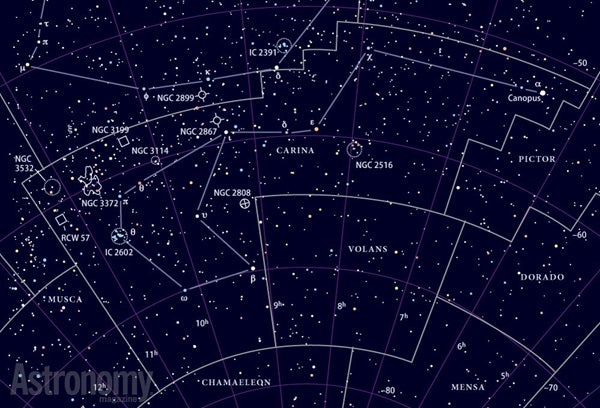Targets for May 12–19, 2016
Small telescope: Open cluster NGC 3114
Large telescope: Spiral galaxy NGC 3344
Large telescope: Irregular galaxy NGC 3448
This week’s small-telescope target is open cluster NGC 3114 in Carina the Keel, and it offers a glorious view. This terrific deep-sky object lies within a spectacular star field. Specifically, you’ll find it 5.8° east-southeast of magnitude 2.2 Aspidiske (Iota [ι] Carinae). Unfortunately, that location means it never rises above the horizon for viewers located north of latitude 30° north.
Although NGC 3114 is visible without optical aid — the cluster shines at magnitude 4.2 — scan the area with binoculars for the best view. NGC 3114 measures 35′ across. That’s an area 27 percent larger than the Full Moon.
Through a 4-inch telescope, you’ll first spot two bright stars in the cluster’s area, magnitude 6.2 SAO 237640 and magnitude 7.3 SAO 237655. Surrounding this pair are dozens of similarly bright stars you’ll form into a variety of patterns. Larger scopes add another layer of faint stars to the background.
While you’re in the area, be sure to take a look at the magnitude 8.8 open cluster Trumpler 12. It lies 0.5° east-southeast of NGC 3114.
Shed no tears
This week’s first large-telescope object is the Sliced Onion Galaxy, also known as spiral galaxy NGC 3344 in Leo Minor the Lion Cub. Look for this magnitude 9.9 object 6.3° east-northeast of magnitude 3.4 Zeta (ζ) Leonis. It measures 6.9′ by 6.4′.
An 8-inch telescope shows a central region that appears bright and concentrated. Double the aperture and you’ll marvel at this classic face-on spiral. Its many arms wind tightly around the core, making the galaxy appear circular.
Two field stars lie superposed on the eastern half of the galaxy. The brightest, and farthest from the center, is magnitude 10.2 GSC 1977:2634.
The other star lies closer in and glows at magnitude 11.5.
Astronomy magazine Contributing Editor Stephen James O’Meara dubbed NGC 3344 the Sliced Onion Galaxy, but not because of its face-on appearance. He likened observing this galaxy to peeling away the skin of an onion, with magnification as your carving tool.
This one wins a cigar
This week’s second large-scope target is irregular galaxy NGC 3448 in Ursa Major the Great Bear. To find it, start at 5th-magnitude 44 Ursae Majoris and move 0.3° southeast. The galaxy glows softly at magnitude 11.6 and measures 4.9′ by 1.4′.
Even the largest amateur telescopes won’t reveal much detail in this galaxy. You’ll see a central bulge and two smaller regions flanking it.
But this galaxy isn’t worth looking at for its beauty or its brightness. Instead, it’s the kind of object it is that makes NGC 3448 special. Astronomers classify it as an amorphous galaxy, a young object in which a large percentage of its mass has not yet formed into stars. The Cigar Galaxy (M82) is the best example of this group.
A 12-inch scope under a dark, steady sky will reveal NGC 3448’s companion galaxy, magnitude 14.2 UGC 6016. Astronomers have determined that a bridge of stellar material connects these two galaxies.
Expand your observing at Astronomy.com
The Sky this Week
Get a daily digest of celestial events coming soon to a sky near you.
Observing Basics
Find more guidance from Senior Editor Michael E. Bakich with his Observing Basics video series.










